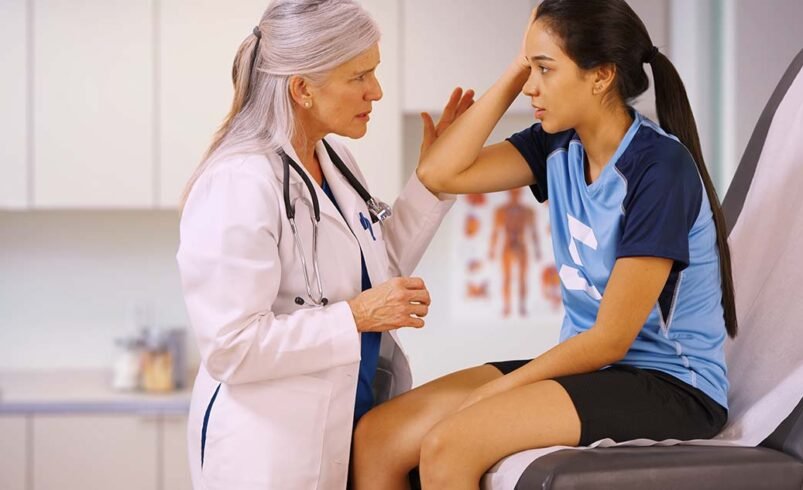A Brief Guide to Concussion Recovery in Mckinney, TX

If you suffer a blow or hit to your head, you might experience immediate symptoms like headache, dizziness, loss of balance, and sensory problems. In other cases, these symptoms may show up days or weeks later. Either way, getting treatment is essential to prevent your symptoms from persisting.
Concussions can be quite uncomfortable, interfering with your daily life. Fortunately, physical therapy can aid concussion recovery. Your physical therapist can monitor your symptoms to create a customized treatment plan. This article explores when you should get medical attention for a concussion and treatment techniques your physical therapist in McKinney, TX, may use.
What Is A Concussion?
A concussion is a traumatic injury to your brain. You can experience a concussion when you suffer a sudden blow or force to your head. Common causes of concussion include work accidents, motor vehicle collisions, falls, and violent events. Concussion affects brain function temporarily and causes symptoms such as headaches and loss of balance, coordination, and memory.
Concussion symptoms can last a few hours to a few days. However, if your symptoms are prolonged, they can last for weeks to months, leading to post-concussion syndrome (PCS).
What Are The Symptoms Of A Concussion?
After suffering a bump or blow to your head, you have a concussion if you experience the following;
- Headache
- Nausea or vomiting
- Inability to concentration
- Feeling sluggish
- Dizziness or blurry vision
- Changes in mood or behavior
- Inability to recall events before or after the hit
When Should You See Your Doctor For Concussion?
Although concussion symptoms may resolve themselves, they may lead to long-term brain damage without proper treatment. It is best to contact your doctor within a day or two after suffering the hit. However, you need emergency care if you experience any of the following;
- Fluid or blood draining from your nose or ears
- Ringing in the ears that doesn’t go away
- A headache that worsens with time
- Loss of consciousness lasting longer than 30 seconds
- Repeated vomiting
- Weakness in arms or legs
- Slurred speech
- Disorientation or confusion
How Does Physical Therapy Work For Concussion Recovery?
McKinney physical therapy uses techniques to address concussion symptoms and provide relief. Your physical therapist will monitor your symptoms and ask about your medical history to develop an appropriate treatment plan. The treatment plan will be progressive and may be adjusted when necessary to ensure full recovery.
Other benefits of physical therapy for concussion include;
- Restored strength
- Improved balance
- Reduced headaches
- Return to normal activity
What Physical Therapy Techniques Are Used To Treat Concussions?
The best physical therapy technique for you will depend on your symptoms and the severity of your condition. Your physical therapist may use one or more of the following to treat you;
Rest And Recovery
Rest is often the first treatment prescribed for a concussion. You should limit any activity until it is safe to return to them. However, too much rest may lengthen your recovery period. Therefore, it is best to limit the activities that trigger your symptoms.
Your physical therapist will design a proper rest and recovery program to help you heal. Adequate rest can help your brain heal and your symptoms clear.
Therapeutic Exercises
Due to the prolonged rest, you may experience muscle weakness. Therapeutic exercises can help you regain your strength and endurance as you heal. Your physical therapist will create a customized exercise program to improve strength and mobility. They will also monitor your symptoms and adjust your exercise program if necessary.
Vestibular Rehabilitation
This treatment technique addresses problems with your vestibular system. It is mostly used to alleviate dizziness and vision problems caused by concussions. Your physical therapist may use habituation and gaze stabilisation exercises to address your symptoms. Habituation exercises expose you to activities that trigger your symptoms. As you gradually get used to the triggers, your symptoms should reduce.
Gaze stabilization exercises, on the other hand, improve your focus and coordination. They involve exercises that improve your visual acuity whenever you move your head.
Electrical Stimulation
Modalities like electrical stimulation are used to treat concussion symptoms. This treatment involves administering electric current through the skin to improve blood flow to the brain and improve cognitive function.
Manual Therapy
Manual therapy involves hands-on techniques like soft tissue and joint manipulation. Your physical therapist can administer manual therapy to your cervical spine to manage concussion symptoms like headache, dizziness, and balance problems.
Conclusion
Without proper treatment, you may be unable to carry out your daily activities if you have a concussion. Frequent headaches, loss of memory and balance, and nausea may become your new normal. Consequently, getting concussion treatment at McKinney, TX, is essential. Fortunately, our physical therapists are patient and will monitor your symptoms to determine the best treatment.
Schedule an appointment with us today!




